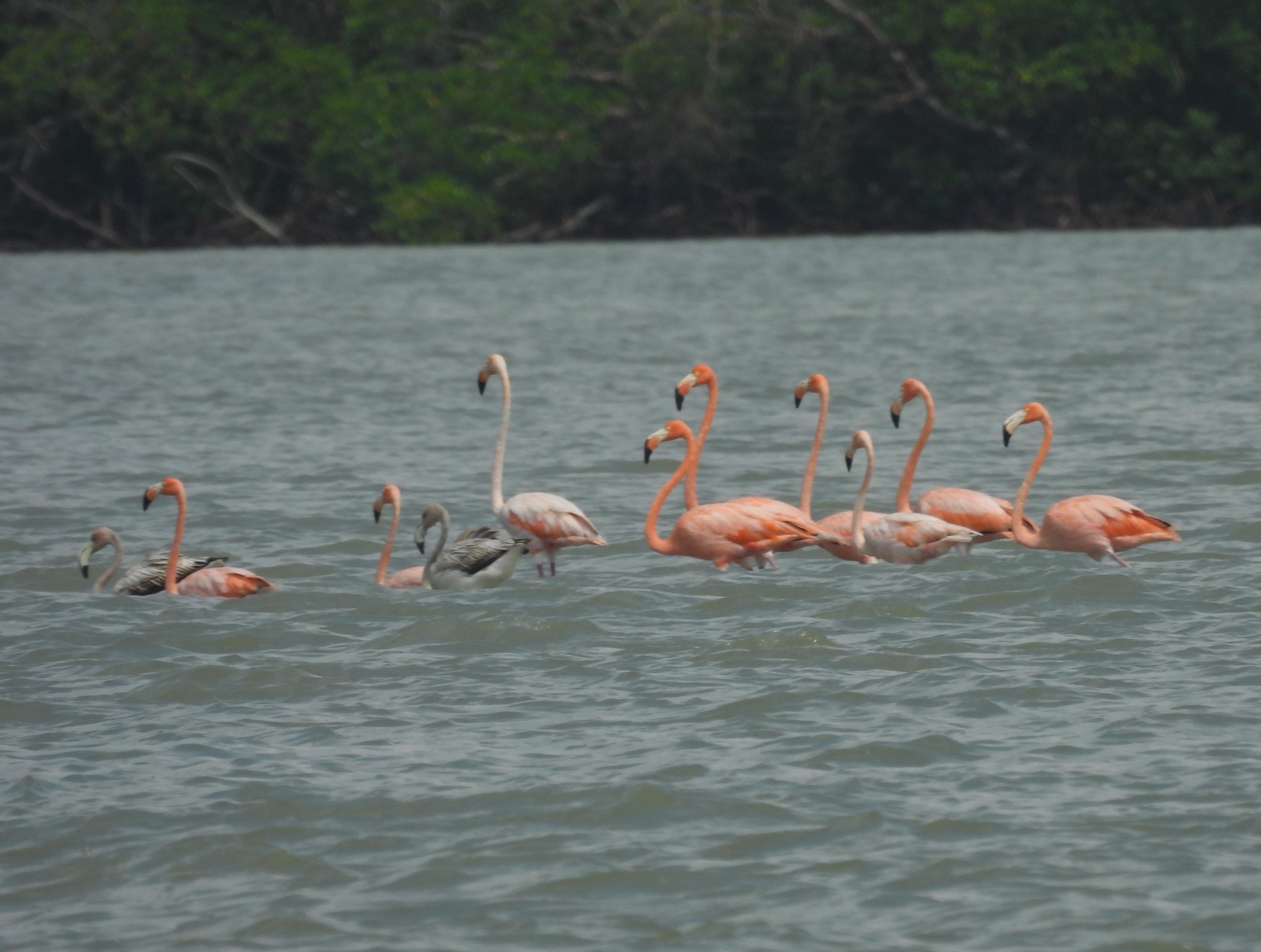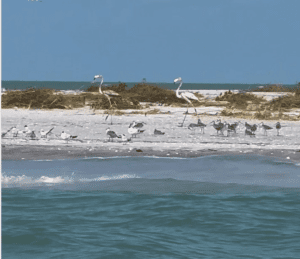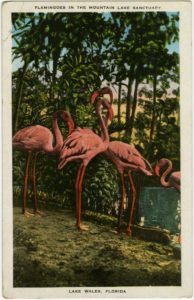Flamingos! Flamingos everywhere! Even in Boca Grande and … Ohio?

Hurricanes don’t always bring good things, but the latest hurricane, Idalia, has not only brought the American flamingo back to Florida, but highlighted the potential for the eventual restoration and return of the species to Florida on a permanent basis.
Like so many Floridians, Ashley Scarpa had never seen them in Florida, even as an experienced birder.
“To be honest I went searching for them,” said Scarpa, who has in the past monitored birds for the U.S. Fish & Wildlife Service. “Someone had posted that they had been seen in the area, and I sprinted to where they have been seen.”
The first report was that five had been seen on the north end of Gasparilla Island. She got in a boat with her husband, Glenn Scarpa, and they looked and found them on the southern tip of Little Gasparilla Island on Thursday, Aug. 31.
Ashley posted a short video on Facebook and Instagram, and wrote up her thoughts.
“I made Glenn take me by boat to check a few nearby spots, and on our last island stop, there they were!” she wrote. “For some reason, I immediately started crying. I’ve always wanted to see a flamingo in the wild. And my gosh, they were so majestic!”
Her first notion, in seeing that the birds were juveniles, was that they were resting and off-course. They were also unbanded, which meant that they had not been domesticated. As a veteran birder, she called the flamingo a “life-bird” that she had hoped to see at least once.
“It was breathtaking,” said Scarpa. “I was speechless.”
Since the storm, flamingos have been seen across Florida, from Palm Beach up to Volusia County and up and down the Gulf Coast. Keith Laakkonen of Audubon’s Corkscrew Swamp Sanctuary had reports of 52 in Estero Bay and a flock of 14 on Marco Island.
Laakkonen said that it was important to remember that storms can have some positive impacts on birds, and they are often seen in the eye of a hurricane. Hurricane Ian, for instance, brought massive amounts of rainfall, which helped.
“A hurricane will reset things,” said Laakkonen, who direct’s Audubon’s 13,000 acre sanctuary in Naples.
“Nature and birds have evolved with these hurricane events,” said Laakkonen. “They can be very successful, and exploit that short-term change.”
Dozens of press reports included a flock, or flamboyance of flamingos, in Pea Island National Wildlife Refuge in North Carolina, a pair in Virginia at Plum Tree Island National Wildlife Refuge in Poquoson, and sightings in Wayne County, Tenn., Ohio and Hale County, Ala.
Sightings in the Tampa Bay area elicited hundreds of shares and comments on social media, including requests for exact GPS coordinates, so that members of birding groups could photograph them. And on Tuesday, Sept. 5, animal rescuers found a tired adult flamingo at St. Pete Beach. The Tampa Bay Times reported that it needed fluid therapy, but it will be released.
Laakkonen believes it is human nature to worry about the birds and how they got there, and how might they get back home, but birds have many advantages and adaptations that we forget about.
“Birds do have wings,” said Laakkonen.
Forgotten by Florida
Most Americans associate flamingos with Florida, but that is mostly because of popular culture, as they were fixtures at roadside attractions like Marineland, Silver Springs, Sarasota Jungle Gardens, the Miami Zoo and Hialeah Racetrack. While tourists almost always saw domesticated flamingos while in Florida, for most of the 20th century they had seemingly disappeared from the Florida landscape. While the passenger pigeon and dodo bird were hunted to extinction, the flamingo survived, barely. Populations began to recover across the Caribbean after World War II, but in the U.S. there were only sporadic sightings.

The birds, however, were not listed because they were not seen when laws on endangered species were instituted. It turned out that the birds were hiding in plain sight in the Everglades, even as they were present all around us in the Bahamas and Cuba.
“There are several populations up the west coast of Florida that appear to have been displaced from the Yucatan by Hurricane Idalia,” said Alyssa Vinson of the University of Florida’s Master Naturalist Program in Manatee County. She said that while they are native to Florida, they are most often seen in the extreme south of Florida near the Ten Thousand Islands and Florida Bay.
A 2018 paper by Stephen Whitfield entitled “Status and trends of American Flamingos,” detailed many of the early sightings of the birds before they were hunted for plumes, to prove the size of local populations. The study details more recent sightings relating to tropical cyclones.
The birds, which Whitfield’s paper called a “Florida icon,” were hunted not only for eating and for plumes, but for their skins, which were reportedly valued at $25 in 1885.
Laakkonen first saw the birds in the wild in Florida while in Palm Beach, at a storm water treatment center. Ornithologists and birders were allowed to come and watch them from a distance.
“You were just hearing these oohs and ahhs, and the sound of a thousand cameras,” said Laakkonen, a native of Cape Coral who has worked at the Charlotte Harbor State Buffer Preserve and was environmental sciences coordinator for Fort Myers Beach. This recent flamingo phenomenon has been remarkable for birding, not only in Florida, but across the U.S., and across ages and groups. He calls the bird an “absolutely beautiful, charismatic bird that everyone knows.”
Restoration and Future
Scarpa, upon seeing the birds, did not post their exact locations. She also reminds that if birds are in this condition, away from their homes, it is best not to stress them by getting close. They are searching for food and need to get somewhere. She recalled a snowy plover that would come each year to the Anna Maria Island area.

“They have somehow imprinted the location for where they go,” said Scarpa.
Laakkonen believes that as long as we can restore habitats and water quality, future generations will get to see flamingos more regularly, and we will see a return, as they are doing fine in other parts of the Caribbean.
“We want to bring back species that were lost over time,” said Laakkonen, who believes there are likely more flamingos in the Everglades than we know, or could ever reach, because of the conditions there. He said “there were always a few down there.”
The flamingos have given many people hope that wild populations, which have heretofore been in inaccessible places in the Everglades, will return across the state eventually and be able to adapt and breed here.
“Is there a chance that some of these juveniles will stay?” asked Scarpa. “Is it possible that some of these guys could take residency?”
The Audubon Society is asking the same question.
“They may stay due to the Everglades restoration,” said Laakkonen. “Or they might fly back to the Yucatan.”









